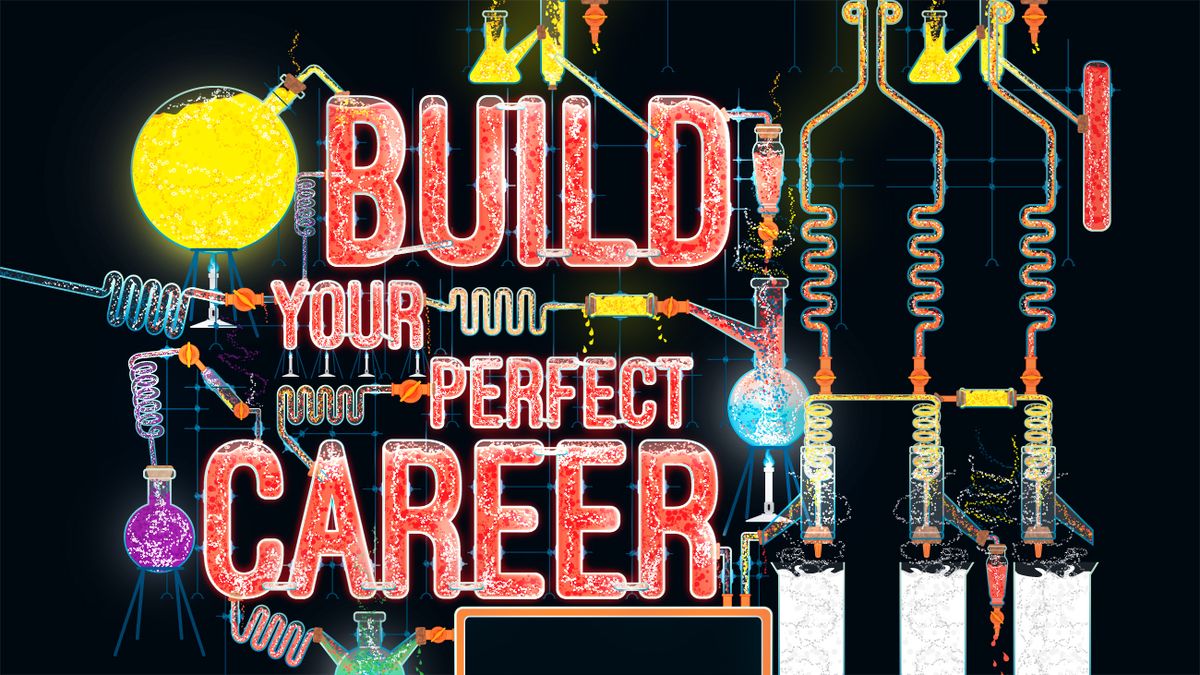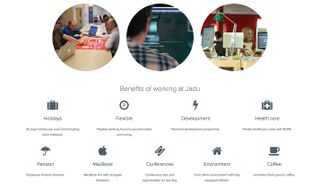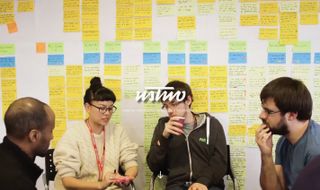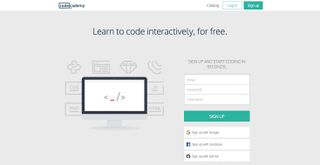
In some professions, the shape and structure of your whole career is mapped out in fine detail from the start. You start by taking an accredited course, gaining specific qualifications and then moving up the ladder of clearly defined job titles and standard salary increments. Web design, though, offers none of that rigid structure, regularity or certainty.
In an industry where the entire nature of what you do can change in a matter of months, there’s nothing predictable about where you’ll be in five years’ time. It’s no surprise, then, that when I asked on Twitter, “Have you always seen a clear path to career advancement, or has it been random and chaotic?” web designers responded overwhelmingly: ‘The latter’.
“When I started, UX didn’t exist, Flash was still a thing and web design was one person writing code in a dark room ,” pointed out Clara Ilena, digital art director at MRM McCann. “As one conference speaker said, ‘If you don’t like changes, you need to get out of the industry ’,” noted Sergei Golubev, founder of The UX Conference. “Things change every day.”
But while web design may lack the clear, predictable career structure of other professions, that doesn’t mean it isn’t important to put some thought into how you want your career to go. In this article, we speak to designers at different levels of the industry, to find out what worked for them, and how we can learn from their example.
Want some top web design resources? See our guides to the best website builder and web hosting solutions.
In-house or freelance?
One of the biggest decisions you have to make throughout your career is whether to stick to a salaried role or go freelance. There’s no right or wrong answer here, but the kind of people who tend to write blog posts, give talks at conferences and pen articles for net magazine tend to be freelance, entrepreneurial types. So it’s easy to get the impression that this is the only route to career success.

That’s certainly not the case, though. And if you dig a little deeper you’ll find countless examples of web designers who’ve carved out fulfilling and well-rewarded careers within a company structure. Take Paul Stanton, who’s been working as senior UI and UX developer for the software platform Jadu since 2012.
Early in his career, he appreciated the freedom to experiment that freelance life offers, he says. “But right now, my full-time job scratches all itches that I have. So I feel less of a need to work in my own time, and all the creative energy, all the things I want to experiment with, I can focus that on the products I work on in my day job.”
As long as he’s learning new things and finding work challenging and enjoyable, he reasons, then why change the status quo? That’s exactly why he stayed in his previous job, at University of Leeds, for four and a half years. “Then a point came where I felt like I’d reached the limits of what I was learning, ” he recalls. “I’d worked on a lot of high-profile projects but they were becoming the same project over and over again. I’d do one faculty website and move on to the next. I wasn’t solving new problems. And so you look for that new challenge.”
I’ve always wanted to work on something I feel passionate about, to feel that the thing I’m working on has value
Paul Stanton
In short, to Stanton, career progression is about focusing on the kind of work you want to do. Get that right, and the salary, job titles and everything else will follow. “Personally, I’ve always wanted to work on something that I enjoy and that I feel passionate about, to feel that the thing that I’m working on has value, ” he explains. “I guess that’s why I’ve not jumped about from job to job, I’ve worked long stints for a couple of different places, mainly because I wanted to do something that I really enjoy.”
And the good news is, it’s the kind of attitude that recruiters admire. As Jim Bowes, CEO and founder of London digital agency Manifesto, says: “Whether we’re hiring someone straight out of college or someone at leadership level, one thread is continuous: what we’re looking for is a real passion."
Generalist or specialist?
A passion for what, though? Which brings us to the issue of whether to be a generalist or a specialist. The number of different specialisms in web design is increasing rapidly: whereas once it was just a choice between visual design and coding, there’s now frontend and backend development, interaction design, UX design, content strategy, not to mention a constant stream of new technologies such as virtual reality, augmented reality and conversational interfaces.
Bowes reckons, though, that you can still be a generalist if that’s what you want. But you do need to tailor your expectations of who’s going to employ you accordingly. “For example, when we were a much smaller business, having multi-skilled people was super-useful, ” Bowes recalls.
“It meant we could be much more flexible in the day-to-day business of getting stuff done for clients. However, as a business you get to the levels of, say, 30 people, you start to compete with real specialists. So you do end up needing people with a greater depth of skill once you get to a certain size. For example, we have a principal UX consultant here with 12 years’ research experience. That enables us to take the level of our work to a new level.”
Whether you’re a generalist or specialist, one thing’s for sure: you can never rest on your laurels. As Andy Thomas, UI/web designer and developer at BookNet Canada, says: “Everything you’re learning now will be obsolete in a few years. So you need to keep learning new things if you want to succeed throughout your career.”
It’s important to do things outside of work ... It’s about branching out and getting new ideas. What you have a passion for will determine what routes your career goes down
Tom Jones, Sum.Agency
Of course, if you’re in a full-time job, you’ll be learning new things all the time. But Tom Jones at London’s Sum.Agency reckons that’s not enough. “I feel it’s important to do things outside of work as well, ” he says. “For example, I want to move into mobile apps, so when I’m outside of the office, I’ll research that myself. It’s about branching out and getting new ideas. What you have a passion for will determine what routes your career goes down.”
That’s not always easy. “It really does get hard, because you go to work and you’re working on a computer all day, ” Jones admits. “And the last thing you want to do when you get home is do the same. But you’ve just got to find that passion for it. You need your downtime, of course, but if you enjoy something, you’ll still find the time to do it on the side.”
His colleague, Adam Brook, concurs. “I never really saw web design and development as a job; it’s always been a hobby for me ,” he says. “It’s always been nice to sit down and do something not only that I’m good at but what I enjoy doing, so to expand on these skills and really develop it in your own time isn’t really a problem.”
Impressing prospective employers
Whether you want promotion within your existing role or a new job with a different company, employers are looking for a mixture of passion and ability. So what’s the best way to show them you have both of those things?
Sometimes you might be lucky enough to get by on a good CV and covering letter, says Bowes. “It often depends on how much we need people at a given time ,” he says. “So if someone sends a CV with a couple of good links and a nice covering letter, and we happen to be searching for someone, they might have luck on their side and just hit that moment.”
But that approach of applying for a job formally is more of an exception than a norm. Getting a job in web design is as much about what’s known as ‘cultural fit’ as skills and ability – that is, they work effectively with the team that's already in place. This means knowing how to network, and getting out there and interacting with people is vital if you want to land your dream job.

Ellis Rogers, a graphic and web designer at Milton Keynes agency Receptional, got both his current and previous jobs this way. “I’ve always been quite network focused ,” he says. “So my current job I got through networking on LinkedIn. And my previous employers I met when I had an exhibition at Glasgow University. They came to speak to me, were shocked that someone with a background in graphic design wanted to do web design, and ate me up.”
Similarly, Keren Lerner, founder and MD of London web design agency Top Left Design, met a recent hire at a Christmas party. “We were chatting and she said: ‘I’m just looking for a company that will really teach me and be patient. I might take a while, but I don’t need to be paid a lot while I’m learning.’ So that kind of attitude really impressed me.”
If you’re not uber-confident socially, though, there are other ways to get noticed and impress employers with your passion and commitment. Bowes’ team, for example, is highly active on the open source communities around the specific programming languages, tools and frameworks they’re interested in.
“Ideally I’d like to plan six months ahead who I’d like to join Manifesto ,” Bowes says. “And so if we can identify who those people are ahead of time, or even know where they’re going to come from – a meetup group or something like that – then that’s definitely something that we look to.
“We also host our own open-source sprints, where people who work in WordPress, Joomla and Drupal are all coming together to do fixes and eat pizza and that kind of stuff. Plus we run a visual content meetup, which is all about cool new visual creative and motion content ideas that we see. And through that we build up a network of people that you know.
In an industry that’s never short of meetups, conferences or open-source projects to get into, there’s no excuse not to get involved in things that can help you meet the right people
“If we’re looking for someone junior or middle-ranking, we’ll be looking at people who attend and take part; if we’re looking for someone senior, we’ll be looking for someone that runs one of them, or speaks at them.”
In short, in an industry that’s never short of meetups, conferences, online groups or open-source projects to get into, there’s no excuse not to get involved in things that can help you meet the right people and boost your career. But be warned: employers will be checking your social media channels to check that you’re as passionate and committed as you claim.
“If we’re interested in someone, we’ll check out their channels to see if they talk about design or code, show their interest in it ,” says Lerner. “Businesses like to see that in young talent: someone who seems to like it so much, they’re willing to share thoughts about it on social media. And we appreciate they’re able to understand they’re marketing themselves as well.”
Building your portfolio
Although in-person or online networking will help you get your foot in the door, it won’t always get you all the way. There will usually be some kind of formal application process to go through, too, especially in larger companies. And it’s at this stage that the quality of your portfolio becomes all important.
Speak to any employer in the industry and two things quickly become clear. The first is that spelling and grammar mistakes will damage your prospect enormously. That might seem obvious, but so many web designers fall down in this area, even at senior levels, that it’s constantly commented on by recruiters. So always get everything checked, double-checked and triple-checked by a reliable friend or colleague.

Secondly, curating your projects carefully, and only selecting the most impressive work, is all important. In the real world, no-one has much time to spend looking at your portfolio, so it needs to be snappy and to-the-point (you can save extraneous work in cloud storage).
As Tim Smith, principal of design at digital project studio Ustwo, explains: “I often find it difficult to get what I need from the portfolio. I want to know what sort of work you’re into and what kind of person you are. But some portfolios make it difficult to do that, often because of designer ego – where they’re trying too hard to be visual and impress. I’d prefer it, though, if they made it easy and quick for me just to understand what I’m interested in; what work you do and who you are.”
Nailing the interview
Also be aware that when it comes to the interview, you’ll be expected to discuss that work in detail. So ensure you’re not making claims you can’t back up, and if a project took place a long time ago, refresh yourself on the details beforehand.
“Whether it’s a GitHub profile or a portfolio, we’ll always want to see examples of the work ,” says Stanton. “Even if it’s not anything that’s deployed in production, or still active, we like to see the thought process behind it. Being able to reference material like that will give us a load of talking points in the interview, and we may end up focusing on a specific project.
“It’s important to get a good sense of the level of involvement a specific person had – whether it was a solo project or if they worked as part of a team. If it was a team, we’ll need to understand their remit and how they integrated with other parts of an organisation.”
If you’re at the very start of your career, of course, then building a portfolio for showing work is hard because you won’t have much in the way to put in it. If you're in such a position, take a look at our article on how to start building up your design portfolio.

Alternatively, Stanton has some advice. “There are plenty of online coding courses like CodeAcademy or Udemy, where you can go through the process and get certificates for the skills that you learn ,” he explains. “Certainly if you’re looking for a junior level position, I want to see someone who’s taken the initiative to go through the process of getting these online qualifications and learning the skills. If they don’t have a portfolio or an active GitHub profile we can see, it still shows that they have a certain level of skill and are willing to learn.”
This article was originally published in issue 299 of net, the world's best-selling magazine for web designers and developers. Buy it here or subscribe.
Read more:

Thank you for reading 5 articles this month* Join now for unlimited access
Enjoy your first month for just £1 / $1 / €1
*Read 5 free articles per month without a subscription

Join now for unlimited access
Try first month for just £1 / $1 / €1
Get the Creative Bloq Newsletter
Daily design news, reviews, how-tos and more, as picked by the editors.
Tom May is an award-winning journalist and editor specialising in design, photography and technology. Author of the Amazon #1 bestseller Great TED Talks: Creativity, published by Pavilion Books, Tom was previously editor of Professional Photography magazine, associate editor at Creative Bloq, and deputy editor at net magazine. Today, he is a regular contributor to Creative Bloq and its sister sites Digital Camera World, T3.com and Tech Radar. He also writes for Creative Boom and works on content marketing projects.
